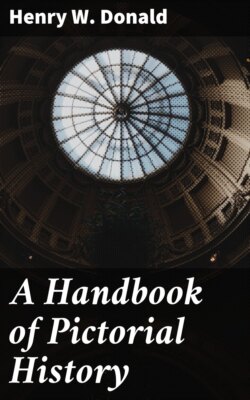Читать книгу A Handbook of Pictorial History - Henry W. Donald - Страница 18
На сайте Литреса книга снята с продажи.
SAXON ANTIQUITIES.
ОглавлениеTable of Contents
PLATE 15.
(Fig. 1): A long Saxon drinking glass, ornamented with raised and decorated ribbons of glass. The bottom is rounded, so that when filled with liquid it had to be emptied at one draught. (British Museum.) (Fig. 2): Another form of Saxon drinking vessel. (British Museum.) (Fig. 3): Old English bronze vessel found in a barrow at Taplow, in Bucks, in 1883, now in the British Museum. (Fig. 4): A silver spoon (Anglo-Saxon) found at Sevington, in Wiltshire, in 1834. (British Museum.) (Fig. 5): Great Seal of Edward the Confessor. The King is represented crowned and seated upon the throne, bearing the sceptre in his right hand and the orb in his left. Edward here calls himself “By the Grace of God, King of the English,” using the Greek and not the Latin term. (Figs. 6 and 7): A silver penny of Alfred the Great, minted at London—(6) the obverse bearing Alfred’s portrait and name; (7) the reverse with the word “Londini” (as a monogram). (Figs. 8 and 9): A silver penny of Edgar the Peaceful—(8) the obverse; (9) the reverse. (Figs. 10, 11, and 12): Three views of King Alfred’s jewel. This was found near the site of Athelney Abbey, Somersetshire, in 1693. Fig. 10, the obverse, is faced with an oval plate of crystal, having under it 39–40 a miniature of a man, in enamelled mosaic (probably St. Neot, Alfred’s special protector), holding in each hand a fleur-de-lys. Fig. 11, the reverse, is a detached plate of gold bearing a fleur-de-lys ornament. Fig. 12, the edge, on which is inscribed “Aelfred Mec Heht Gewyrcan” (Alfred bid me be wrought). The stalk end bears a grotesque figure, apparently the head of a sea monster. It may have been the head of a stylus or pen, or have served as a standard in battle. (Ashmolean Museum, Oxford.) (Fig. 13): An ornamented fibula or brooch at Goldsborough, Yorkshire. (British Museum.) (Fig. 14): An Anglo-Saxon comb—St. Cuthbert’s comb, at Durham Cathedral.
